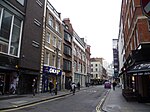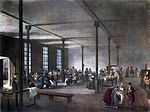Framestore

Framestore is a British animation, visual effects company and creative studio based on Chancery Lane in London. Formed in 1986, it acquired (and subsequently merged with) the Computer Film Company in 1997. It works on feature films and television, commercials and immersive projects including VR experiences, digital signage and theme park attractions. Framestore employs about 2500 staff — 1000 in London, and 1500 spread across offices in Chicago, New York, Los Angeles, Montreal, Vancouver, Mumbai and Beijing.In its current incarnation, Framestore delivers images for feature films, television drama, advertising, console and online games, internet and mobile phone applications, and is Europe's largest post-production house.
Excerpt from the Wikipedia article Framestore (License: CC BY-SA 3.0, Authors, Images).Framestore
Noel Street, London Soho
Geographical coordinates (GPS) Address Nearby Places Show on map
Geographical coordinates (GPS)
| Latitude | Longitude |
|---|---|
| N 51.515055555556 ° | E -0.13658333333333 ° |
Address
Waverley House
Noel Street 7-12
W1F 8GJ London, Soho
England, United Kingdom
Open on Google Maps







